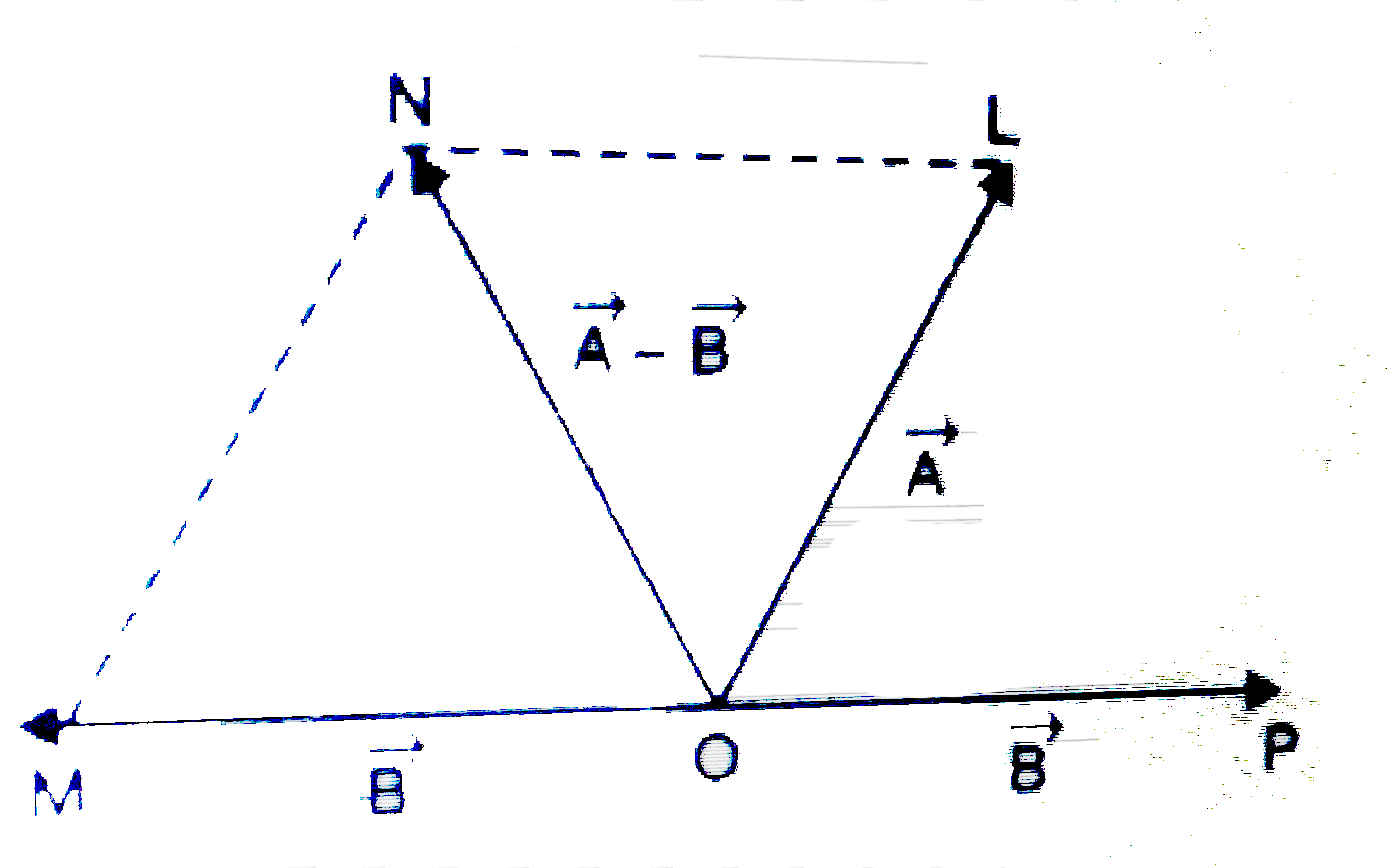Establish the following inequalities geometrically or otherwise ,
(a) ∣∣→A+→B∣∣≤∣∣→A∣∣+∣∣→B∣∣ ,
(b) ∣∣→A+→B∣∣≥∣∣∣∣→A∣∣−∣∣→B∣∣∣
(C )∣∣→A−→B∣∣≤∣∣→A∣∣+∣∣→B∣∣
(d) ∣∣→A−→B∣∣≥∣∣∣∣→A∣∣−∣∣→B∣∣∣
When does the equality sign above apply ?
Consider two vectors →A and →B be represented by the sides −−→OP and −−→OQ of a parallelogram OPSQ. According to parallelogram law of vector addition, (→A+→B) will be represented by −−→OS as shown in Fig. Thus,
OP = ∣∣→A∣∣, OQ=PS=∣∣→B∣∣
and OS = |verA+verB|
a) To prove ∣∣→A+→B∣∣←∣∣→A∣∣+∣∣→B∣∣
We know that the length of one side of a triangle is always less than the sum of the lengths of the other two sides. Hence from Δ OPS, we have,
OSltOP+PS or OSltOP+OQ or ∣∣→A+→B∣∣<∣∣→A∣∣+∣∣→B∣∣..............(i)
If the two vectors →A and →B are acting along the same straight line and in the same direction
then, ∣∣→A+→B∣∣=∣∣→A∣∣+∣∣→B∣∣..............(ii)
Combining the conditions mentioned in (i) and (ii) we have
∣∣→A+→B∣∣←∣∣→A∣∣+∣∣→B∣∣
b) To prove ∣∣→A+→B∣∣>−∣∣∣∣→A∣∣−∣∣→B∣∣∣
From ΔOPS, we have OS+PS>OP or OS>|OP−PS| or OS>|OP−OQ|............(iii) (∴ PS=OQ)
The modules of (OP-PS) has been taken because the L.H.S is always positive but the R.H.S may be negative if OP<PS. thus from (iii) , we have,
∣∣→A+→B∣∣>∣∣∣∣→A∣∣−∣∣→B∣∣∣ .............(iv)
if the two vectors →A and →B are acting along a straight line in opposite directions, then
∣∣→A+→B∣∣=∣∣∣∣→A∣∣−∣∣→B∣∣∣............(v)
Combining the conditions mentioned in (iv) and (v), we get
∣∣→A+→B∣∣≥∣∣∣∣→A∣∣−∣∣→B∣∣∣
c) To prove ∣∣→A−→B∣∣≤∣∣→A∣∣+∣∣→B∣∣
In fig. →OL and −−→OM represents vectors →A and →B respectively. Here −−→ON represents −−−−→A−B.
consider the Δ OMN,
ON<MN+OM
∣∣→A−→B∣∣<∣∣→A∣∣+∣∣−→B∣∣............(vi)
When →A and →B are along the same line, but points in the opposite direction, then
When →A and →B are along the same straight line, but points in the opposite direction, then
∣∣→A−→B∣∣=∣∣→A∣∣+∣∣→B∣∣............(vii)
combining equation (vi) and (vii), we get
∣∣→A−→B∣∣←∣∣→A∣∣+∣∣→B∣∣
d) To prove ∣∣→A−→B∣∣≤∣∣→A∣∣+∣∣→B∣∣
Let us consider the ΔOMN,
ON+OM>MN or ON>[MN−OM]
since, MN=OL ∴ ON>|OL−OM|
or ∣∣→A−→B∣∣>∣∣∣∣→A∣∣−∣∣→B∣∣∣...................(viii)
When →A and →B are along the same straight line and point in the same direction,then
∣∣→A−→B∣∣=∣∣→A∣∣−∣∣→B∣∣............(ix)
Combining equations (viii) and (ix), we get
∣∣→A−→B∣∣≥∣∣∣∣→A∣∣−∣∣→B∣∣∣


Topper's Solved these Questions
- MOTION IN A PLANE BOOK - NCERT ENGLISHCHAPTER - MOTION IN A PLANE EXERCISE - EXERCISE
32 Videos
- MECHANICAL PROPERTIES OF SOLIDSBOOK - NCERT ENGLISHCHAPTER - MECHANICAL PROPERTIES OF SOLIDSEXERCISE - EXERCISE
21 Videos
- MOTION IN A STRAIGHT LINEBOOK - NCERT ENGLISHCHAPTER - MOTION IN A STRAIGHT LINEEXERCISE - EXERCISE
28 Videos
Similar Questions
Establish the following inequalities geometrically or otherwise ,
(a) | vec A + vec B| -lt | vec A | + |vec B|,<br> | vec A + vec B| gt- ||vec A- | vec B||<br>(C) | vec A- vec B| -lt | vec A| + vec B|<br>(d)∣∣→A−→B∣∣>−∣∣∣∣→A∣∣−∣∣→B∣∣∣
When does the equality sign above aplly ?
View SolutionFor any two vectors →aand→b , prove that ∣∣→a+→b∣∣≤|→a|+∣∣→b∣∣
View SolutionFor any two vectors →aand→b , prove that ∣∣→a+→b∣∣≤|→a|+∣∣→b∣∣ (ii) ∣∣→a−→b∣∣≤|→a|+∣∣→b∣∣ (iii) ∣∣→a−→b∣∣≥|→a|−∣∣→b∣∣
View SolutionFor any two vectors →a, →b ∣∣→a.→b∣∣≤|→a|∣∣→b∣∣
View SolutionWhat is the angle between (→A+→B) and (→A×→B) ?
View SolutionFor any two vectors →aand→b prove that ∣∣→a+→b∣∣≤|→a|+∣∣→b∣∣
View SolutionIf →a+→b=→cand|→a|=∣∣→b∣∣=|→c| find the angle between →aand→b
View SolutionProve that [→a+→b,→b+→c,→c+→a]=2[→a,→b,→c]
View SolutionFor any vector →a and →b prove that ∣∣→a+→b∣∣≤|→a|+∣∣→b∣∣.
View SolutionProve that [→a,→b,→c+→d]=[→a,→b,→c]+[→a,→b,→d]
View Solution
